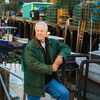Come together | Economic development groups in Franklin County join forces to create Church Street Commons
Now, Hagerstrom hopes she's eliminated that problem by creating Church Street Commons, a joint economic development facility in Farmington that will house GFDC, CEI, AVCOG and Mountain Counties Heritage Inc. in a renovated building that used to house a printing company. The groups hope their shared space will not only make them more accessible to clients, but also spur greater collaboration between organizations to promote further development in the region.
GFDC, AVCOG and CEI expected to occupy about 1,100 sq. ft. in the 10,000-square-foot building by the beginning of this month. Each organization will have its own office space, but they will share a common reception area and conference rooms, presentation areas and other open space ˆ an arrangement that Hagerstrom says made it economically feasible for the groups to lease bigger space than any one group could have on its own. Besides taking office space in the building, Mountain Counties Heritage also plans to develop over the next few months a "heritage discovery center" on the building's first floor, which will feature displays of the region's natural history and culture, and showcase locally made products.
Mainebiz recently spoke with Hagerstrom about the concept behind Church Street Commons, and what benefits she hopes to see from sharing space with her economic and community development counterparts. An edited transcript of the conversation follows.
Mainebiz: You've talked about the new facility allowing you to provide one-stop shopping for businesses needing economic development assistance. Why is that a good approach for the kind of work you do?
Hagerstrom: There are a couple of reasons, I think. The first one is simply being more accessible to the clients. The locations that we were all at before were difficult to find, and so coming together in one place makes us easier to find.
And the big reason the three of us are coming together is that we really offer a range of services. Greater Franklin Development Corp.'s mission is primarily creating jobs through business attraction. Then we have CEI, who is counseling small business and getting the entrepreneurs started and small businesses growing. And Sarah [Doscinski of AVCOG] is a development specialist, so she works with existing businesses primarily to make sure they are taking advantage of the programs that are available to them.
But she also works with me in business attraction, because she's my source for putting together a proposal from the state for businesses that I would be attracting to this area, so there's a nice match there. She would also work with small businesses, in addition to what Janet [Roderick of CEI] does, to make sure they're also taking advantage of programs that are available to them. I think for the three of us, we're excited because it's going to make us more accessible for communication with each other. There will be less of a chance of duplicating efforts. I don't think that we duplicate now, but this certainly will make that less of a chance and we'll really have a better picture of the area.
It sounds like each group has resources that could help each other's clients, so do you expect this facility to make it easier to show clients what else is available to them?
Exactly. For instance, I had a client that wanted to make a move from Montana to Maine and visited with me for about five days. If Sarah had been here at that time, we could have more easily coordinated with her on things like a questionnaire that the Department of Economic and Community Development requires [for new businesses looking for assistance]. She could have been right there and talked to him and perhaps even visited with me. We do that sometimes now, but just being under one roof makes it easier to coordinate. Sarah also is the resource who puts together training programs that might be necessary for my clients coming in as well, and explaining what's available to them ˆ the Maine Quality Centers, for instance, and the Governor's Training Initiative.
We are looking to be able to complement each other in a stronger way. We can do that if we're sharing the same space, and we still have yet to discover some of the things that can happen. I think what we'll really try to do is communicate on a regular basis, whether it's monthly or quarterly, to talk about what's going on and things that need to be done. If I know that I have a business coming in, I can give them a heads up that we might need this or this ˆ you know, that kind of thing. And it gets them in the loop so things aren't always at the last minute. There are a lot of things we can do without betraying confidentiality, which is something that we all highly respect amongst each other, but we do hope to leverage each other for projects once we start communicating more intentionally.
Is there anything that is potentially proprietary or territorial among the groups that you'll need to protect in order to make this work?
I don't think we compete with each other. I think we have a certain amount of respect for how things happen. For instance, if a business came to Sarah at AVCOG and wanted to work with her, she certainly would mention Greater Franklin and my services available to them. And sometimes, because they might know her or she's had some contact with another part of their business, they want to work with her. And that's okay. We're all working for the good of the area. We don't think of each other as competitors but more as collaborators to make things happen, because we're focused on improving the quality of life through job creation in the greater Franklin County area.
How long had you been thinking about the concept of a shared facility?
I've been in this position for about two-and-a-half years, and shortly after I came on board we started thinking about this. We were realizing that we worked closely together, and thought, "Wouldn't it be great if we could share space?" And of course Bruce Hazard from Mountain Counties Heritage also felt that his work in heritage tourism and developing culture across the counties is also an economic driver. He's been interested in this concept, too, and wanted to be a piece of it.
So he and I, sort of being the local leaders for this, have been talking to CEI and AVCOG and we've even talked with some chambers. But it really filtered down to this being the best mix [of organizations]. We've looked at other possibilities for different space within the last couple of years, but it wasn't the right timing. None of us can afford to buy a building and do it ourselves, and so it was actually the right time and the right place kind of thing.
This building was bought by developers [Joe Carlson and Steve Braconi from Massachusetts] in January, who had been working with me for a couple of years because they're interested in this area. And so when they said they had this building I said, "I have this idea I'd like to share with youˆ " and it just sort of went from there.
Location was very important to all of our organizations. We were all in downtown Farmington and I think we needed to stay there. We all felt that it was really important to stay visible in the downtown, trying to create some energy and making it easier for people to get to us.
Being downtown also seems particularly important to Mountain Counties Heritage and its discovery center. How does having that facility in the same building complement your mission of business attraction?
I know Bruce would like to showcase products that are made in western Maine and develop some signature products and branding of the area. He also wants to have displays of the natural history of the area and also the culture of the area. Farmington has a historic downtown, and heritage tourism really attracts people.
For me, I see this as a nice combination because if my office is located in the same building, [visitors] see the sign that says Greater Franklin Development Corp. and that I'm responsible for attracting businesses. It's the visitors that I'm trying to reach ˆ the people who like to come here that might be a business owner in New York or Massachusetts or wherever. They may get to thinking, wow, I'd like to live here.
How else do you plan to explore the opportunities offered by all being in the same place?
Once we all get here and people are settled and have everything moved in, I think we will deliberately set a time to meet and discuss what we're doing and what makes sense ˆ do we want to meet as a group once a month, or every other month or quarterly? I think we still have to decide some of those things. We haven't all been able to be in the same place at one time, and I will probably have more frequent meetings with one group or the other from time to time just because of the nature of the project or the client I'm working on. But I think we are really excited about sitting down together and saying, "How can we leverage each other and meet the missions we all have?" We're just anxious to sit down and see what a brainstorming session will create among us.









Comments